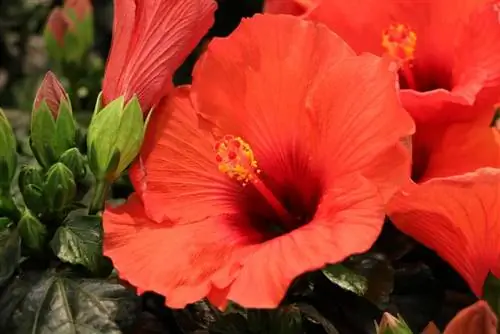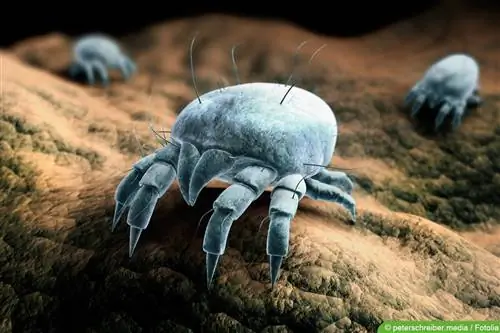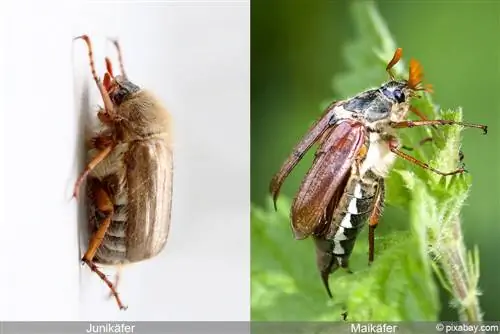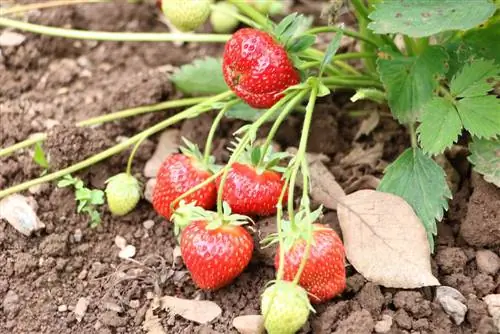- Author admin [email protected].
- Public 2023-12-17 03:39.
- Last modified 2025-01-24 12:45.
Plant pests on hibiscus (bot. Hibiscus) are usually only discovered when the first visible damage to he alth can already be seen. This particularly affects the hibiscus in the garden. Then at the latest you have to react. For most pests, chemical poisons are available from specialist retailers. Many of these are often not environmentally friendly and are sometimes so concentrated that they can also affect human he alth. It makes more sense to rely on natural control agents. You can find out what these are in the following guide.
Aphids
The hibiscus attracts aphids especially when fresh shoots sprout. Whole colonies of aphids gather on them. They can be recognized by their small spherical shape. In terms of color, they stand out in black or light green from the lush green shoots of the hibiscus. They measure around two millimeters in size and also attack flowers and leaves. Here they feed on the sap that they suck out of the plant. As a result, the leaves turn brown and die, as do the shoots. Flowers remain closed and fall down.
Combat
If it is a hibiscus as a houseplant, it should be immediately removed from the vicinity of other plants if aphids are discovered. When hibiscus is planted in a garden bed, this is not possible, especially with larger specimens. Smaller hibiscuses and especially young plants with heavy aphid infestations should be transplanted from the garden soil into a container and isolated as a precaution.
Whether they have been changed or not, the aphids are relatively easy to collect. All you need to do is brush off the pests on the affected parts of the plant with your thumb and forefinger slightly pressed together. However, since you will not be able to reach all of them in this way, or you may miss some, move on to the next step in combating them, where you can achieve effective results in a natural way, without having to use the chemical club:
- Shower the plant with a strong jet of water
- Make soapy water: one tablespoon of soap to one liter of water
- Alternative: chop up nettles and make an infusion with water
- Spray indoor and garden hibiscuses dripping wet with soapy water or nettle infusion
- Repeat the process every two days for a week
- If there is a severe infestation, rub plant parts with the lye or infusion
- After about ten days the plant can return to its usual location
Tip:
Some hibiscuses require high humidity, which is why the Chinese hibiscus variety, for example, should be covered with a translucent plastic bag to make it airtight after spraying.
Herbal remedies
Pest control of aphids on hibiscus is also easier and less time-consuming using organic products. Plant products that contain the ingredient “Neem” are recommended. Neem sticks or neem in liquid form are ideal for watering. The active ingredients reach the roots directly and work from within. They reach the tips of the leaves and fight aphids when they suck out the plant sap.
Prevention
If you regularly give your hibiscus specimen a shower with soapy water/nettle infusion or water it with a neem product every four to eight weeks, you will keep aphids at a safe distance. You can also surround the garden hibiscus with certain types of herbs. Sage, lavender, savory and thyme are ideal for aphid prevention. Their scent repels pests.
For indoor hibiscuses, it is recommended to lift a few herb stems or leaves underground or into the substrate. Moisture releases their fragrances and reaches the plant's interior via the roots, which leads to the aphids' appetite being spoiled.
Spider mites
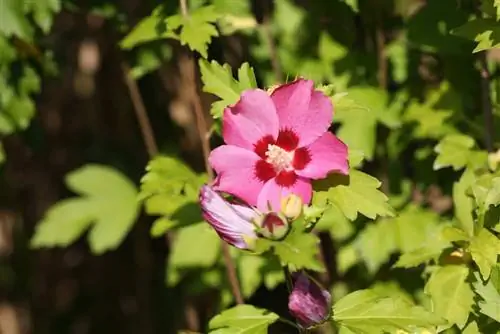
The indoor hibiscus in particular is particularly at risk of being attacked by spider mites in winter due to dry air conditions caused by heating.
These can be recognized by their yellow, orange or red color and, if you look closely, by their four pairs of legs. They are mainly found on the undersides of leaves, where they attach themselves. The infestation with spider mites is most noticeable when they spread small white webs that stretch across the leaves and sometimes on the hibiscus stems. The leaves react to this infestation with a yellow discoloration and then ultimately fall off.
Combat
A natural method has proven to be very effective in combating spider mites:
- In the shower or in the garden bed, shower hibiscus with high water pressure
- Make dishwashing liquid: two tablespoons of dishwashing liquid per liter of water
- Wipe the leaves carefully with the detergent solution
- After each wiping of an infected leaf, clean with a cloth or sponge in the lye
- Put the plant inside a transparent plastic bag or a plastic garbage bag
- Seal this airtight
- Let the hibiscus rest for about a week
Tip:
Normal garbage or plastic bag sizes are usually not enough for larger garden hibiscons. Plastic films are ideal here, such as those available for painting in specialist shops or hardware stores.
Pesticides
Numerous insecticides are available in specialist plant shops that are specifically effective against spider mites. Here it is advisable to use a natural, biodegradable product. Chemical insecticides should only be used outdoors, as they can also have negative effects on human he alth in closed rooms.
For example, it has been noted several times that asthma is made worse by the use of chemical products. That's why natural pesticides, such as those offered by Bayer, among others, which work just as effectively, are more advisable.
Prevention
Room hibiscuses in particular should be sprayed regularly as a precaution. This prophylactic against spider mites is particularly effective in winter and when the humidity in the room is dry, as they shy away from moisture. Daily ventilation also supports prevention. If the plant is in the garden bed, a regular shower has a preventative effect, especially on hot summer days. But be careful: never water the hibiscus in full sun.
Beetle
Not all beetles are plant pests. Many of them have a special role in the ecosystem and should not be killed. However, some specimens, especially hibiscuses, make life difficult. These include in particular the sweetmouth (Otiorhynchus) and the bacon beetle (Dermestidae), which generally like to attack ornamental plants. Ladybugs, on the other hand, are very valuable for plants. For example, they eat annoying aphids.
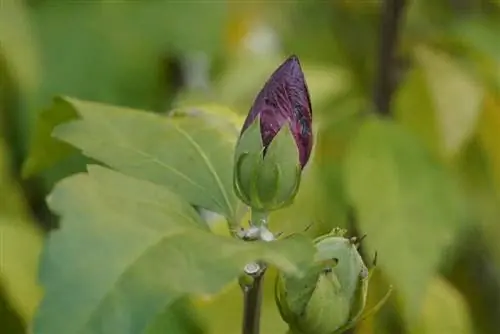
A beetle infestation on a hibiscus can usually be suspected by crescent-shaped or circular holes and eaten notches on the leaves. The plants suddenly wither and the hibiscus trunk withers. The beetles can also be seen with the naked eye because, depending on the species, they are up to 14 millimeters or more in size. Some are nocturnal and hide in the plant soil during the day. Others, however, also spread in the environment outside of plants or dive into the potting soil as soon as they sense danger. It is therefore not easy to see beetles visually, so typical plant damage indicates an infestation.
Tip:
They are particularly active from May to October, although isolated animals can also be seen feeding on the hibiscus in winter.
Combat
If you are not sure whether there is a beetle infestation or whether it is a plant pest, you can try luring away. To do this, place a bowl or flower pot next to the hibiscus plant and fill it with damp cardboard, wood shavings and/or hay. This attracts most beetles, especially for sleeping. Early in the morning or before nightfall you can pour the pot into a plastic bag and see if there are any beetles in it. If this is the case, repeat this luring method several times until there are no more beetles to be discovered.
If there are visible beetles on your hibiscus specimen, place a cloth or household paper under the plant pot. Now shake the trunk so that the beetles fall down. Landed on the cloth or paper, you can now collect it and release it into the open air.
Pesticides
Since beetles like to lay their larvae quickly in hibiscus soil, chemical pest control is advisable, especially in the case of a severe infestation, in order to quickly get the situation under control. Natural, organic-based products usually require a few days to work effectively. During this time, the first larvae could already be laid out, which often require different pest control than adult beetle species.

The gardening trade has some offers available, such as “Permethrin”. This is a muscle and nerve poison that works quickly. In order not to expose yourself to the poison, it is recommended to only use it outdoors and, above all, to keep children and pets at a safe distance during treatment.
Precaution
You can effectively prevent beetle infestation by pouring garlic tea. Depending on the watering rhythm, this should be mixed into the watering water every other time.
Conclusion
Pests such as aphids, spider mites and beetles can cause a lot of damage to your hibiscus and often lead to its complete death. You should therefore always check your plants for possible infestation so that you can react quickly with a suitable control measure as described here.

